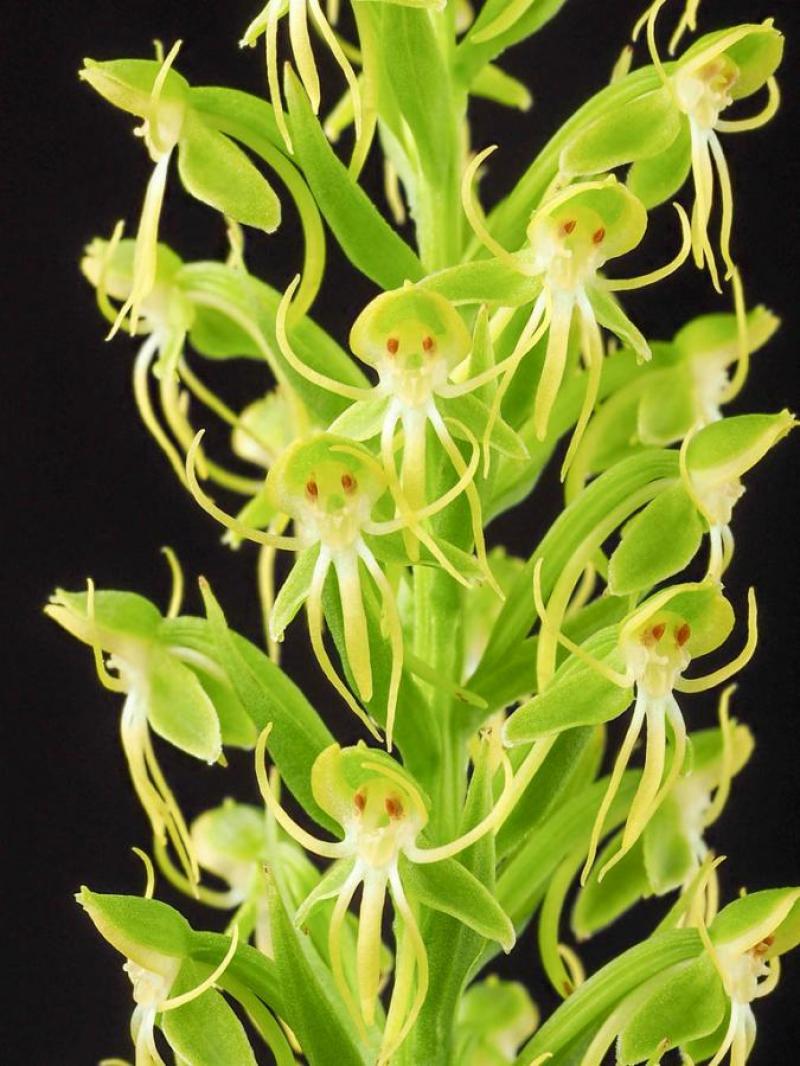Habenaria repens
Also known as: The Crawling Habenaria or Platanthera foliosa Habenaria radicans Habenaria nuttallii Habenaria repens var. repens Habenaria repens var. maxillaris Habenaria pseudorepens Habenaria sceptrodes Habenaria maxillaris Habenaria palustris Habenaria paucifolia var. estolonifer Water-Spider Orchid in the subfamily: Orchidoideae
Native to: Alabama - United States California - United States Colorado - United States Cuba Departamento del Huila - Colombia Florida - United States Georgia Georgia - United States Illinois - United States Maine - United States Missouri - United States New Mexico - United States New York - United States Oaxaca - Mexico South Carolina - United States Tennessee - United States Texas - United States
General Information
The Crawling Habenaria is a small to large cool to warm growing terrestrial orchid belonging to the sub family Orchidoideae native to United States, Cuba, Colombia, Georgia, and Mexico.
Plant Description
Grows to 0.5-50cm. Each new growth has numerous erect lance shaped leaves that grow to 1-8cm long. Pseudobulbs grow to 50cm
Flowers
Numerous blossoms appear during Winter and Spring
Blooming Season
- Spring
- Winter
Care Notes
These orchids grow on the forest floor so are used to rich soil containing plenty of organic matter that is always moist (but not always wet), and prefer constant conditions in terms of humidity, temperature and water supply. They may not be as forgiving as epiphytes in regards to sudden changes in growing conditions so it is wise to ease them into new conditions over a the space of a few days, and repot as infrequently as possible.
Keep an eye on the plants condition regularly as they can decline suddenly if the conditions are not just right. It is more important to keep water supply constant rather than frequent - overwatering often causes rot which can quickly set in, especially in warmer conditions.
These can be grown in shady, moist areas in the garden, supplied they have protection from abrupt changes caused by the elements, e.g. dry winds, frost etc. Being grown around companion plants such as ferns and bromeliads will help build and retain the humidity they require throughout the year.
Climate
Grows at low to high elevations. Rainfall ranges from 56mm to 183mm per day, heaviest in July and lightest in November. Humidity ranges from 70% to 83%, highest in September and lowest in March. Temperature ranges from 6C to 31C, highest in July (24C to 31C) and lowest in January (6C to 14C).
Watering
These orchids prefer a constant supply of moisture, with a slight drying out between waterings. Saucers can be placed under pots to retain moisture during hot weather, however the saucers should be removed or let to dry every 1-2 weeks to prevent rot. Keep an eye on the plant especially in hot weather and look for cues of under/overwatering and adjust accordingly.
Fertiliser
Apply liquid based fertiliser per recommended directions. They can benefit from a high phosphate fertiliser leading up to flowering season, followed by a high nitrogen fertiliser when new growth appears, and a balanced fertiliser in other times. These orchids can also tolerate slow release fertiliser applied 1-2 pellets per cup (250ml) of media.
Use balanced fertiliser during Spring and Summer. Apply fertiliser regularly at half strength year round. Use a high Nitrogen fertiliser during Spring and Summer. Use a high Phosphorous fertiliser during Summer.Potting
These plants can be sensitive to repotting though should not require repotting regularly. Repotting should be done when the mix has broken down to the point that it doesn't absorb water or holds onto water for far too long, usually the plant shows a decline in growth as well.
The mix should be free draining, with a blend of 30% inorganic ingredients such as coarse sand, gravel or perlite, mixed in with about 70% organic ingredients such as peat, leaf litter or decomposed bark. Avoid commercial potting mixes as they can vary wildly and may contain "wetting agents" that can hold onto water for loo long, causing rotting and stunted growth.



















